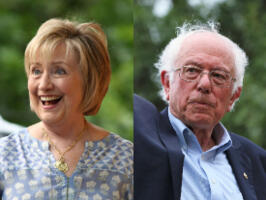Hillary's Irish Feast Fantasy
A Commentary By Dick Morris
"I was deeply involved in the Irish peace process"
Those words were uttered by Hillary Clinton — with a straight face!
Ever since she began her campaign for the presidency, Hillary and Bill Clinton have both boldly — and falsely — claimed that she played an important role in the Irish peace process. Suddenly rewriting history, they’ve claimed that her success in bringing peace to Ireland is all part of the vast experience that makes her qualified for the White House.
It’s funny that they both forgot to mention her magical diplomatic skills in their respective memoirs.
But now her recently released White House schedules show that Hillary’s assertions are one big fantasy. Hillary’s role in all of the Irish visits were no different than any other first ladies, the ones who didn’t think that accompanying the president to a foreign country was a major diplomatic coup.
The daily schedules show that Hillary visited Ireland on numerous occasions with the President. For the most part, her role was to stand next to him, shake hands, and occasionally introduce him before he gave a speech. Sometimes, she met with women’s and children’s groups.
For example, on a trip to Ireland in late November and early December in 1995, she attended the speech given by the president in Derry, Northern Ireland. Her role: to shake hands after the speech. Later that day, the first couple traveled to Belfast, where they lit the Christmas tree outside of City Hall. After the Lord Mayor announced the winners of the annual "letter writing and poster contest," Hillary read excerpts from the children’s letters.
When the Clintons flew to Dublin the next day, Mrs. Clinton toured the National Gallery, where she signed the guest book. In the afternoon, she did give a 25 minute speech to about 350 women from all over Ireland. This meeting seems to be at the heart of her exaggerated contentions that she helped the peace process by bringing both sides together. But published reports indicate that the women advocating peace in Northern Ireland and the Irish Republic were well known to each other long before the meeting. And a 25 minute speech outside of government channels was hardly the cause of the end of a bitterness that began almost a hundred years ago. Immediately afterwards, she introduced the president to a crowd of 30,000 people at Trinity College, where he spoke to the Irish people.
In 1997, she participated in a roundtable discussion with students in Northern Ireland and met with representatives of various Youth Councils.
In September 1998, she accompanied the president when he made a speech to the people of Northern Ireland. Noble Peace Price Laureate David Trimbell was present. He recently had this to say about Hillary’s role in the peace process:
“Hillary Clinton had no direct role in bringing peace to Northern Ireland and is a "wee bit silly" for exaggerating the part she played.”
He continued:
"I don’t know there was much she did apart from accompanying Bill [Clinton] going around," Her recent statements about being deeply involved were merely "the sort of thing people put in their canvassing leaflets" during elections. "She visited when things were happening, saw what was going on, she can certainly say it was part of her experience. I don’t want to rain on the thing for her but being a cheerleader for something is slightly different from being a principal player.”
When the President of Ireland, Mary Robinson, visited the White House, Hillary was not invited to her Oval Office meeting with the president. Instead, she hosted an informal coffee for Mr. Robinson.
How could they discuss important peace matters without Hillary?
On another trip, in October 1999, when she was already a Senate candidate, Hillary gave a Millenium Speech in Galway.
In January 1999, she did a "drop-by" for 15 minutes to say hello to women from Northern Ireland. Later, in June, she did another 15 minute "drop-by" to see the Children’s Friendship Project of Northern Ireland.
After she was elected to the Senate, in December 2000, she attended a reception in Dublin for prominent Irish women, visited the Guinness Store, and the Belfast Opera. She made some short remarks at the Opera.
On October 24, 1997, Hillary received a briefing on Ireland from a group that included George Mitchell, Larry Butler of the NSC, and Randy Bell, from the Ireland Office of the State Department and members of her staff that was held immediately before meeting with Mary Robinson, then UN High Commissioner for Human Rights. A week later, she went to Ireland for a dinner at Dublin Castle for 22 people, and a roundtable discussion with 10 students.
Does that sound like the schedule of a woman who was instrumental in the Irish peace process?
By the way, even with her limited schedule that did not involve the president, Hillary routinely took five or six of her own staff people on the Irish trips.
But her claim to any role in the Irish peace process is pure fantasy.
COPYRIGHT EILEEN MCGANN AND DICK MORRIS 2008.
See Other Commentary By Dick Morris
See Other Political Commentary
Rasmussen Reports is a media company specializing in the collection, publication and distribution of public opinion information.
We conduct public opinion polls on a variety of topics to inform our audience on events in the news and other topics of interest. To ensure editorial control and independence, we pay for the polls ourselves and generate revenue through the sale of subscriptions, sponsorships, and advertising. Nightly polling on politics, business and lifestyle topics provides the content to update the Rasmussen Reports web site many times each day. If it's in the news, it's in our polls. Additionally, the data drives a daily update newsletter and various media outlets across the country.
Some information, including the Rasmussen Reports daily Presidential Tracking Poll and commentaries are available for free to the general public. Subscriptions are available for $4.95 a month or 34.95 a year that provide subscribers with exclusive access to more than 20 stories per week on upcoming elections, consumer confidence, and issues that affect us all. For those who are really into the numbers, Platinum Members can review demographic crosstabs and a full history of our data.
To learn more about our methodology, click here.



